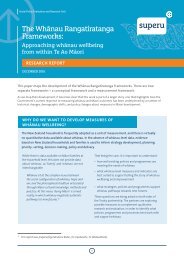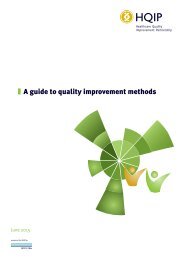2fyY1Py
2fyY1Py
2fyY1Py
Create successful ePaper yourself
Turn your PDF publications into a flip-book with our unique Google optimized e-Paper software.
Background<br />
The prevention and control of noncommunicable diseases is a core priority of WHO and its Member States. These diseases<br />
are currently the leading cause of death and disability in the WHO European Region and are responsible for more deaths<br />
worldwide than all other causes combined, and it is predicted that, by 2030, 52 million deaths per year will be attributable<br />
to them (4). Driven by lifestyle risks such as an unhealthy diet, noncommunicable diseases are increasingly occurring in<br />
younger people, due to e.g. overweight and obesity, raised blood pressure and blood glucose, and abnormal blood lipids<br />
(5). In some countries, children and adolescents account for 20–50% of cases of new-onset diabetes (6), and young people<br />
increasingly present with risk factors for cardiovascular diseases, including pre-hypertension (7).<br />
In Europe, overweight and obesity are highly prevalent among children and adolescents, particularly in southern countries.<br />
The WHO European Childhood Obesity Surveillance Initiative has shown that, in some countries, almost 50% of eight-yearold<br />
boys are overweight and more than 25% are obese (8). Such alarming high rates of childhood obesity, increasingly<br />
seen worldwide in high- and low-income countries alike, not only pose a health risk but also breach the right to health, as<br />
stated in the United Nations International Covenant on Economic, Social and Cultural Rights (9), and children’s rights to the<br />
development and enjoyment of the highest attainable standards of health in the United Nations Convention on the Rights<br />
of the Child (2). As States are obliged not only to respect and protect but also to fulfil human rights, they are obliged to act<br />
on this global risk to health.<br />
WHO set global targets to halt the rise in obesity in the Global Action Plan on the Prevention and Control of<br />
Noncommunicable Diseases (10) and the Comprehensive Implementation Plan on Maternal, Infant and Young Child<br />
Nutrition (11). Subsequently, the report of the WHO Commission on Ending Childhood Obesity (ECHO Commission) (3),<br />
based on consultations with 118 WHO Member States, made comprehensive recommendations to reduce children’s and<br />
adolescents’ intake of foods and non-alcoholic beverages high in saturated fats, salt and/or free sugars (hereafter “HFSS<br />
foods”) to limit excess weight gain. A core recommendation is to reduce children’s and adolescents’ exposure to all forms of<br />
marketing for such foods, including in digital media, in view of “unequivocal evidence that the marketing of unhealthy foods<br />
and sugar-sweetened beverages is related to childhood obesity”. A recent review for the United Kingdom’s Committee of<br />
Advertising Practice argued, however, that there is insufficient academic evidence of exposure or impact on which to base<br />
new regulations regarding digital HFSS food marketing to children and adolescents (12). Nevertheless, digital marketing,<br />
including for HFSS foods, is reported by brands and marketers themselves not only to be very successful but also to further<br />
amplify the effects of HFSS marketing in “traditional” media, enhancing advertisement (ad) attention and recall, brand<br />
awareness, attitudes and purchase intent and product sales (13–16).<br />
The aim of this report is to summarize the evidence on children’s exposure to HFSS food marketing in digital media and<br />
the persuasive power of that exposure. The term “child” is used to cover all children and adolescents under the age of 18<br />
years, in line with the United Nations Convention on the Rights of the Child (2) and the WHO ECHO Commission report (3). 1<br />
We also consider methodological challenges to research in this emerging field. We then outline existing regulation of HFSS<br />
marketing to children and consider the challenges of regulations to reduce children’s exposure to digital HFSS marketing.<br />
As this is an emerging, transdisciplinary field, an expert review method was selected. Experts in HFSS marketing (its effects<br />
and regulation), public health, digital marketing, child rights, digital law and other relevant fields were consulted to obtain<br />
the most recent evidence available. Overall, the report focuses, when possible, on evidence from and regulatory action in<br />
the WHO European Region (much of the evidence to date has been generated in western Europe). Nevertheless, as findings<br />
on the effects of food marketing are similar throughout the world, the evidence, challenges and implications for policy<br />
development are likely to be applicable throughout the European Region and globally.<br />
1<br />
“Convention on the Rights of the Child, Treaty Series, 1577:3 (1989): PART I, Article 1 defines a child as every human being below the age of eighteen years unless, under the<br />
law applicable to the child, majority is attained earlier. The World Health Organization (WHO) defines adolescents as those between 10 and 19 years of age. The majority of<br />
adolescents are, therefore, included in the age-based definition of “child”, adopted by the Convention on the Rights of the Child, as a person under the age of 18 years.”<br />
4






